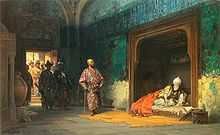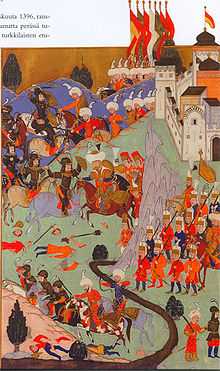Bayezid I
Bayezid I | |
|---|---|
| Ottoman Sultan | |
 | |
 | |
| Reign | 1389–1402 |
| Period | Rise of the Ottoman Empire |
| Predecessor | Murad I |
| Successor | Interregnum |
| Consort |
Devlet Shah Hâtûn Devlet Hâtûn Hafsa Hatun Sultan Hatun Olivera Lazarević, Despina Hâtûn Maria Hatun Angelina Hatun |
| Royal House | House of Osman |
| Dynasty | Ottoman Dynasty |
| Father | Murad I |
| Valide Sultan | Gülçiçek Hatun |
Bayezid I (Ottoman Turkish: بايزيد اول; Turkish: 1. Beyazıt; nicknamed Yıldırım (Ottoman Turkish: ییلدیرم), "Thunderbolt"; 1354 – 8 March 1403) was the Sultan of the Ottoman Empire from 1389 to 1402. He was the son of Murad I[2][3] and Valide Sultan Gülçiçek Hatun.
Biography

Bayezid ascended to the throne following the death of his father Murad I, who was killed by Serbian knight Miloš Obilić during (15 June), or immediately after (16 June), the Battle of Kosovo in 1389, by which Serbia became a vassal of the Ottoman Empire. Immediately after obtaining the throne, he had his younger brother strangled to avoid a plot. In 1390, Bayezid took as a wife Princess Olivera Despina, the daughter of Prince Lazar of Serbia,[4] who also lost his life in Kosovo. Bayezid recognized Stefan Lazarević, the son of Lazar, as the new Serbian leader (later despot), with considerable autonomy.

From 1389 to 1395 he conquered Bulgaria and northern Greece. In 1394 he crossed the River Danube to attack Wallachia, ruled at that time by Mircea the Elder. The Ottomans were superior in number, but on 10 October 1394 (or 17 May 1395), in the Battle of Rovine, on forested and swampy terrain, the Wallachians won the fierce battle and prevented Bayezid's army from advancing beyond the Danube.[5]
Meanwhile, he begin the reunification of the Turkish Anatolia, conquering the beyliks of Aydin, Saruhan in 1390, the beyliks of Mentese, Germiyan and Kastamonu in 1391; and finally the great emirate of Karaman and the ex-emirate of Burhan-ad-Din in Tokat, Sivas and Kayseri(1397–98). Next he occuped the cities of Malatya and Elbistan, in a war with the mamluk sultan of Egypt.
In 1394, Bayezid laid siege to Constantinople,[6] the capital of the Byzantine Empire. Anadoluhisarı fortress was built between 1393 and 1394 as part of preparations for the Second Ottoman Siege of Constantinople, which took place in 1395. On the urgings of the Byzantine emperor Manuel II Palaeologus a new crusade was organized to defeat him. This proved unsuccessful: in 1396 the Christian allies, under the leadership of the King of Hungary and future Holy Roman Emperor (in 1433) Sigismund, were defeated in the Battle of Nicopolis. Bayezid built the magnificent Ulu Camii in Bursa, to celebrate this victory.

Thus, the siege of Constantinople continued, lasting until 1402.[7] The beleaguered Byzantines had their reprieve when Bayezid fought the Timurid in the East.[8] At this time, the empire of Bayezid included Thrace (except Constantinople), Macedonia, Bulgaria, and parts of Serbia in Europe. In Asia, his domains extended to the Taurus Mountains. His army was considered one of the best in the Islamic world. In 1400, the Central Asian warlord Timur succeeded in rousing the local Turkic beyliks that had been vassals of the Ottomans to join him in his attack on Bayezid, who was also considered one of the most powerful rulers in the Muslim world during that period. In the fateful Battle of Ankara, on 20 July 1402, Bayezid was captured by Timur and the Ottoman army was defeated. Many writers claim that Bayezid was mistreated by the Timurids. However, writers and historians from Timur's own court reported that Bayezid was treated well, and that Timur even mourned his death. One of Bayezid's sons, Mustafa Çelebi, was captured with him and held captive in Samarkand until 1405.
Four of Bayezid's sons, specifically Süleyman Çelebi, İsa Çelebi, Mehmed Çelebi, and Musa Çelebi, however, escaped from the battlefield and later started a civil war for the Ottoman throne known as the Ottoman Interregnum.[9] After Mehmed's victory, his coronation as Mehmed I, and the death of all four but Mehmed, Bayezid's other son Mustafa Çelebi emerged from hiding and began two failed rebellions against his brother Mehmed and, after Mehmed's death, his nephew Murat II.
Legacy
A commando battalion in the Pakistan Army is named Yaldaram Battalion after him.
Marriages and progeny
His mother was Valide Sultan Gülçiçek Hatun who was of ethnic Greek descent.[2][10]
Marriages
- Devlet Shah Hâtûn (m. 1381), daughter of Süleyman Shah (Şah Çelebi) of the Germiyanids
- Devlet Hâtûn (m. 1365), daughter of Yakub Shah of the Germiyanids, a descendant of Rumi
- Hafsa Hatun (m.1390), daughter of Isa Bey of the Aydinids
- Sultan Hatun, daughter of Süleyman Shah of the Dulkadirids
- Olivera Lazarević, Despina Hâtûn (m. 1389), daughter of Prince Lazar of Serbia
- Maria Hatun, Princess of Hungary, daughter of János, Count of Hungary, whose second husband was Payo Gómez de Sotomayor after Bayezid's capture
- Angelina Hatun
Issue
- Ertuğrul Çelebi, mother unknown
- Süleyman Çelebi (1377–1411), co-sultan of Rumelia, mother unknown
- İsa Çelebi (1380–1406), governor of Anatolia, with Devlet Hatun
- Mehmed Çelebi (1389–1421), governor of Anatolia, and later sultan Mehmed I Çelebi (1413–1421), with Devlet Hatun
- Mustafa Çelebi (1393–1422), with Devlet Shah Hatun
- Musa Çelebi (d. 1413), sultan of Rumelia (1410–1413), with Devlet Shah Hatun
- Şehzade Musa - son, with Angelina Hatun
- Şehzade Kasım - son
- Şehzade Yusuf - son, converted to Christianity, changed his name to Demetrios[11]
- Erhondu Hatun - daughter
- Hundi Hatun - daughter
- Fatma Hatun - daughter
In fiction

The defeat of Bayezid became a popular subject for later Western writers, composers, and painters. They embellished the legend that he was taken by Timur to Samarkand with a cast of characters to create an oriental fantasy that has maintained its appeal. Christopher Marlowe's play Tamburlane the Great was first performed in London in 1587, three years after the formal opening of English-Ottoman trade relations when William Harborne sailed for Constantinople as an agent of the Levant Company. In 1648, the play Le Gran Tamerlan et Bejezet by Jean Magnon appeared in London, and in 1725, Handel's Tamerlano was first performed and published in London;[12] Vivaldi's version of the story, Bajazet, was written in 1735. Magnon had given Bayezid an intriguing wife and daughter; the Handel and Vivaldi renditions included, as well as Tamerlane and Bayezid and his daughter, a prince of Byzantium and a princess of Trebizond (Trabzon) in a passionate love story. A cycle of paintings in Schloss Eggenberg, near Graz in Austria, translated the theme to a different medium; this was completed in the 1670s shortly before the Ottoman army attacked the Habsburgs in central Europe.[13] Bayezid (spelled Bayazid) is a central character in the Robert E. Howard story Lord of Samarcand.[14]
Notes
- ↑ Lokman (1588). "Battle of Nicopolis (1396)". Hünernâme.
- ↑ 2.0 2.1 Lowry, Heath W. (2003) The Nature of the Early Ottoman State. Albany, NY: State University of New York Press, p. 153
- ↑ Runciman, Steven The Fall of Constantinople. Cambridge: Cambridge University Press, p. 36
- ↑ Bayezid I, Halil Inalcik,The Encyclopedia of Islam, Vol. I, Ed. H.A.R.Gibb, J.H.Kramers, E. Levi-Provencal and J.Schacht, (Brill, 1986), 1118.
- ↑ John V.A. Fine, The Late Medieval Balkans, (The University of Michigan Press, 1994), 424.
- ↑ Mango, Cyril. The Oxford History of Byzantium. 1st ed. New York: Oxford UP, 2002. p. 273-4
- ↑ Nancy Bisaha, Creating East And West: Renaissance Humanists And the Ottoman Turks, (University of Pennsylvania Press, 2004), 98.
- ↑ Dimitris J. Kastritsis, The Sons of Bayezid: Empire Building and Representation in the Ottoman Civil War of 1402-13, (Brill, 2007), 5.
- ↑ Dimitris J. Kastritsis,1-3.
- ↑ Shaw, Stanford Jay (1976) History of the Ottoman Empire and Modern Turkey; Vol. 1: Empire of the Gazis; the rise and decline of the Ottoman Empire, 1280-1808. Cambridge: Cambridge University Press ISBN 0-521-21280-4; p. 28
- ↑ Dimitris J. Kastritsis, 41.
- ↑ London: Printed & sold by J. Cluer, [1725]
- ↑ Finkel, C. (2006) The History of the Ottoman Empire: Osman's Dream. New York: Basic Books; p. 30
- ↑ Howard, Robert E. (1973) Sowers of the Thunder, Ace Science Fiction
References
- Goodwin, Jason (1998) Lords of the Horizons. London: Chatto & Windus
- Harris, Jonathan (2010) The End of Byzantium. New Haven and London: Yale University Press ISBN 978-0-300-11786-8
- Imber, Colin (2002) The Ottoman Empire. London: Palgrave/Macmillan ISBN 0-333-61387-2
- Nicolle, David (1999) Nicopolis 1396: The Last Crusade. Oxford: Osprey Books ISBN 978-1-85532-918-8
External links
| Wikimedia Commons has media related to Bayezid I. |
| Bayezid I House of Osman Born: 1354 Died: 8 March 1403[aged 47–48] | ||
| Regnal titles | ||
|---|---|---|
| Preceded by Murad I |
Sultan of the Ottoman Empire 1389 – 8 March 1403 |
Succeeded by Mehmed I |
| |||||||||||